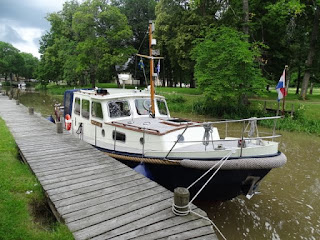After Harstena, we spent a night in Stegeborg, where there is a castle ruin. That was a bit disappointing, yes there is a ruin, but there is little information about it and it's in a bad state (I guess ruins generally are, but those that are open to the public at a fee usually have some educational value...


This morning, we set course for Söderköping. We were there two years ago, it is almost at the end (or beginning, depending on where you start) of the Göta canal. We quite enjoyed it then and in addition our fridge was looking rather empty this morning and supermarkets are few and far between on the islands so we decided to go back for another visit. We however did not want to go into the Göta canal. Even a ticket for the canal stretch between Mem and Södeköping costs 750 SEK, about 75 Euros. So we decided to take the Storån, a very small river. Interestingly, the Storån is the river that Söderköping owes its existence to: Around 1200, the town was founded here when the river was much bigger. The landmass of Southern Sweden has been (and still is) rising ever since the weight of the ice disappeared after the ice age. So Söderköping, which is now well above sea level, was then much lower and the river was big enough for shipping to enter. It was then one of the most important trading towns in Sweden. Today, it is a nicely preserved old town, where the history is well represented. There have been many archeological digs which have found well preserved remains of what was here before, in the middle ages and even earlier in the Viking age.
In addition, the Göta canal has given the town an extra touristic impulse: it is the most attractive of the towns along the canal and the banks of the canal are full of tourists that visit the harbour and the shops and restaurants along it. A very nice and festive atmosphere!
In the harbour on the Storån, not the Göta canal!
Traditional Swedish 'phone booth
The bell tower. The church behind it dates from the 1500's, the original one burned down (several times actually. Like so many towns in the middle ages, fires gutted towns with depressing regularity)
The house of bishop Hans Brask. The plants are called 'stokrozen' in Dutch, I don't know the english name for them. You see them a lot in Sweden as well as in Denmark. When we first saw them in Denmark three years ago we though they were weeds (they were not in bloom then)!
Of course we walked to the canal harbour as well, where we were surprised to see this:
An enormous 'Sunseeker'. Of course it had to fit in the small canal locks, otherwise it could not possibly be here. But what would that look like? Fortunately our curiosity was satisfied:
Not quite Onbekommerd....
This is also our 'point of return'. Tomorrow we'll go down the Storån again and then down the Slätbaken and south into the skärgård. We will slowly start making our way South again.

















































